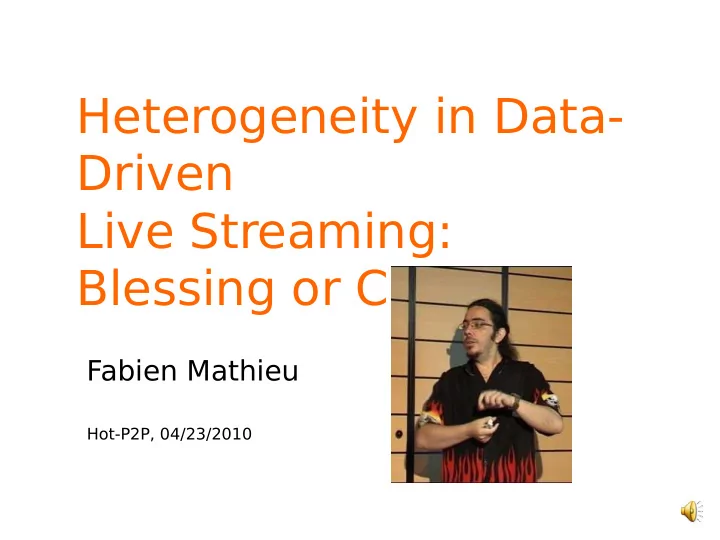

Heterogeneity in Data- Driven Live Streaming: Blessing or Curse? Fabien Mathieu Hot-P2P, 04/23/2010
Roadmap Problem statement Model Motivation Optimal broadcasting of a single chunk Many-to-one One-to-one One-to-c T owards fast broadcasting of a stream of chunks Curses Blessings 2/22
The Live Streaming Problem A live stream (streamrate s ) to watch… = U : n s s ᄈ Injected by a server of capacity c 0 Watched by a set of N peers… Goal #1: make it work! Goal #2: make it fast! 3/22
Chunk-based (aka data-driven) diffusion Chunk-based: the stream is split into chunks of equal size; Integrity-rule: only forward fully received chunks; Upload-constrained: delay comes from upload bandwidth u1 ¸ … ¸ uN ; Bandwidth are expressed in chunks per second No overlay constraints ! Oversimplified model to focus on heterogeneity 4/22
Optimal delay in the homogeneous case Homogeneity allows to work in slotted time log ( N n / ) � � � � 2 0 The best way to broadcast one chunk takes u Extends to a stream of chunks by permutation of the single chunk tree 5/22
Optimal delay in the heterogeneous case Nice formula for the optimal single chunk transmission: failed Direct link single chunk / stream of chunks: failed Intuition: should be faster (centralization is the extreme case) In practice: (Bonald et al. , Sigmetrics, 2208) Summary: heterogeneity is a b…. 6/22
Model extension: forwarding policies Authorize collaborations, or force parallelism: Many-to-one: any set of peers with a chunk can forward that chunk in time 1/ ∑ιυι. Νοτ ρεαλιστιχ ατ αλλ, βυτ σο εασιερ το χοµπυτε; Ωιλλ ηελπ υνδερστανδ τηε οτηερ µοδελσ. Ονε−το−ονε (µονο−σουρχε): α πεερ ι ωιτη α χηυνκ χαν φορωαρδ ιτ ιν τιµε 1/υι. τηε γενυινε µοδελ; σλοωερ τηαν µανψ−το−ονε, βυτ µορε ρεαλιστιχ. Ονε−το− χ (παραλλελισµ): α πεερ ι νεεδσ ατ λεαστ χ/υι το φορωαρδ α χηυνκ, υπ το χ πεερσ σιµυλτανεουσλψ. Εξτενδ τηε χλασσιχαλ µοδελ; παραλλελισµ χαν αϖοιδ βανδωιδτη ωαστε, βυτ ιτ σλοωερ. 7/22
Delays under the model 8/22
Example 3 peers, s=1, n0=u1=1, u2=u3=1/2 Exactly the bandwidth required according to Bandwidth Conservation Law (BCL) Equivalent homogeneous system: n0=1, u=2/3 Streaming is the issue 9/22
Single CHUNK 10/22
Results for the single chunk transmission Dm is given by a simple greedy algorithm: Gives Absolute, tight, lower bound for chunk transmission. Homogeneous case: 11/22
Results for the single chunk transmission D1 is also given by a simple greedy algorithm. No simple, closed formula. Theorem: Conjecture (sigh!): Price of atomicity is Extension to parallelism: Price of parallelism is 12/22
STREAM OF CHUNKS 13/22
Streaming case: feasibility 14/22
Bad case scenario In the one-to-one model, poor peer may affect the delay if you have to use them at some time This can happen even in overprovisionned scenarios 15/22
Good case 1: emulating homogeneity Assume we can find u such that − N n u 0 s ᄈ (BCL of the emulated system) N � � u ¥ i N ᄈ � � u � � i (emulation condition) Then we have + � log ( M / n ) � 1, with � � % 2 0 = D M : #{ / i u u } ( M N ) ᄈ ᄈ ᄈ 1 i u Poor peers (ui<u) are never used Sufficient condition for u to exist: factor 2 BW provisioning for quantification 16/22
Good case 2: avoiding competition 17/22
Good case 2: avoiding competition Idea: protect the early diffusion to emulate the Dr · 1 case. Recipe: Split the peers into E equal subsets, (E¼ Dr) All subsets should have roughly the original BW distribution. Round-robin the chunk injection among the subsets. Primary goal: intra-diffusion of the chunk. Secondary goal (when idle): broadcast to other subsets 18/22
Good case 2: avoiding competition Proper validation of the idea still on-going Quantification effects can make some BW useless The subset must be as similar as possible (one monster peer in a single subset is hard to handle) Lead to condition u ¸ r(1+1/E)+cst, with E¼ log(N/n_0). Corresponding delay almost like D For some slightly overprovisionned systems, the stream delay is almost like the chunk delay 19/22
Chunk-based model and delay: summary For homogeneous systems, single delay=stream delay Collaboration for one chunk transfer is not that useful Parallelism is not that scary Heterogeneity speeds up single delay Some bandwidth overprovisioning seems to be required in the general case 20/22
And then? Limits of the chunk-based model Chunks comes from BitT orrent’s world Integrity purpose Great for unstructured approaches Big chunk reduce overhead Good for theory Quantification Delay expressed as bandwidth But when streaming is concerned… Need to go down to latency timescales Limits of the model validity A possible lead for future work Do we really need strong integrity mechanisms? T ry to learn from the stripe world 21/22
Thank you very many! No interactive questions, but you can • Have a look at the paper • Email me (fabien.mathieu@orange-ftgroup.com) 22/22
Recommend
More recommend